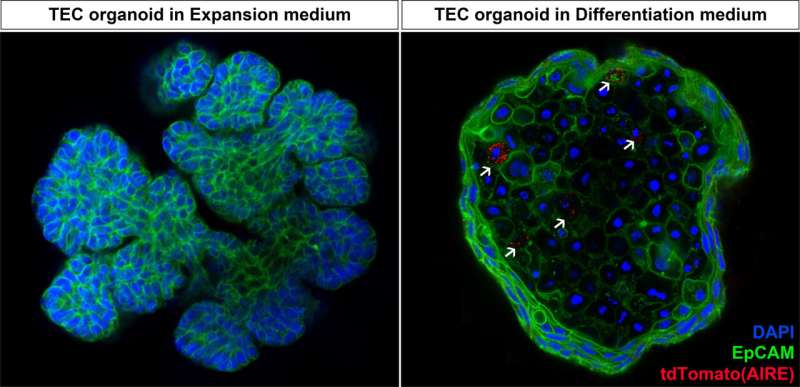This article has been reviewed according to Science X's editorial process and policies. Editors have highlighted the following attributes while ensuring the content's credibility:
fact-checked
peer-reviewed publication
trusted source
proofread
Scientists develop new organoid model to study thymus function

Researchers from the Organoid group have developed a new organoid model that can be used to study the thymus. The organoids are derived from mouse thymus tissue, specifically model thymic epithelial cells (TECs). These cells are responsible for training the T cells of the immune system to properly respond to pathogens.
It is the first laboratory model that enables long-term culture of TECs, which presents new opportunities to study their function. Ultimately, this could also bring new insights into the treatment of patients with impaired thymus function. The study was published in Cell Reports on 27 March 2024.
Our immune system protects us from pathogens like viruses and bacteria. In order to effectively detect and eliminate these, several types of white blood cells are required, including T cells.
Before they can do their job, T cells need to be trained to only attack pathogens and not the body's own cells. This happens in the thymus, a small organ located behind the breastbone.
The "teachers" in this training process are called TECs. They present all kinds of molecules to the T cells and eliminate those that do not respond properly. The end result is mature T cells that enter the bloodstream, ready to respond to pathogens.
Researchers studying TECs need a way to grow these cells in the laboratory. The Organoid group has now succeeded in developing a new system: TEC organoids, based on thymus tissue from mice.
First author on the study Sangho Lim explains the advantage of these organoids compared to previous systems, "Before, it was not possible to keep TECs alive in culture for long. This made it difficult to study them and to do experiments. Our TEC organoids can be kept in culture for over two years, so that allows for long-term experiments."
Compared to other culture systems, the organoids are also a better representation of the diversity of TECs in the body. Specifically, two different subtypes of TECs exist, cortical and medullar TECs, depending on where in the thymus they are present. These subtypes also have specific functions in training T cells.
"By adding a different cocktail of molecules to the organoids, we can direct the cells to specialize into the cortical and medullar subtypes. Before, it was difficult to get this diversity of TECs in culture," Lim says.
Lim and his colleagues also confirmed that the TECs in the organoids were capable of doing their job: training T cells.
"We first mixed the organoids together with immature T cells in culture. We then followed their maturation by looking at the molecules CD4 and CD8 on the outside of the cells. In the body, immature T cells acquire and lose these molecules in a specific order during their development. This corresponded nicely with what happened in our culture plates," says Lim.
The researchers obtained similar results in mice born without a thymus. Lim adds, "These mice have very low numbers of mature T cells in the blood, because they have no thymus to train them. When we transplanted our TEC organoids under their skin, we saw a very clear increase of the amount of mature T cells in their blood."
It therefore seems that the TEC organoids were capable of taking over the function of the missing thymus by stimulating T cells to mature.
The mouse TEC organoids open up new possibilities for scientists studying the thymus and T cell maturation. From a clinical perspective, this is especially relevant for patients with impaired thymus function, a condition that can be due to specific cancer treatments or neonatal heart surgeries.
"In the future, we might be able to explore transplantation of TEC organoids as a treatment strategy to restore thymus function. But a lot of work still needs to be done before we get there," Lim concludes.
More information: Sangho Lim et al, Derivation of functional thymic epithelial organoid lines from adult murine thymus, Cell Reports (2024). DOI: 10.1016/j.celrep.2024.114019



















